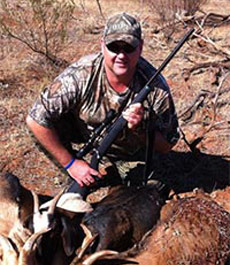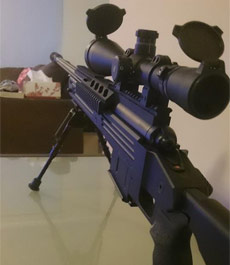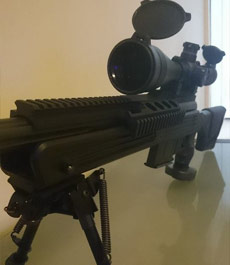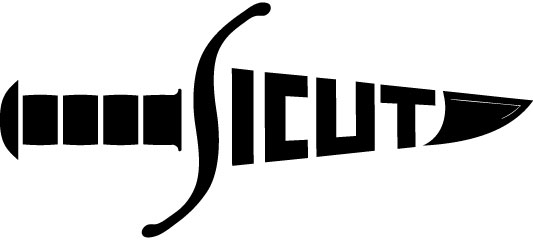Hunt, Catch, Cook - Hunting
Hunting Safety
Gun and Hunting safety is essentially the application of common sense. The primary rules must be used before taking up any hunting. There are no second chances when it comes to firearm safety.
- Treat every gun with the respect that you would a loaded gun.
- Watch where you point the muzzle. Carry your gun safely - keep the safety on until you are ready to shoot and never think because the safety is on the firearm is 100% safe.
- Unload guns when not in use. Remove magazines, open bolts or take down actions; guns should be carried in cases to the shooting area and never pull a gun out of the gun case or bag toward you by the muzzle.
- Be sure the barrel is clear of obstructions, and your ammunition is the correct ammo for the gun and in good order. Be sure of your target before you pull the trigger; know and identify the features of your game you are hunting and be 100% sure before you pull the trigger.
- Never point a gun at anything you do not want to kill. Very self-explanatory…once that trigger is pulled.
- Never jump a fence, climb a tree, jump a ditch or other obstacle with a loaded gun; even disembarking a vehicle to retrieve game or open a gate can be done once you have put the gun down.
- Never shoot a bullet at a flat, hard surface or water; when sighting in or at target practice be sure to use a backstop that is adequate and never shoot at the skyline.
- Store guns and ammunition separately and safely - beyond the reach of children and those unauthorised to use them.
- Avoid alcoholic beverages before or during shooting. Refuse to shoot with others whom you know are under the influence of alcohol or drugs. There will be plenty of time after the hunt to partake a beverage and storytelling.
- Always know where your hunting companions are if you are hunting in a group and never shoot game that flushes between you and your companion.
Be a responsible hunter and practice safety and self control, always insist that your companions comply with safety obligations. If you set the example and the standard and they do not wish to comply... Leave them at home!

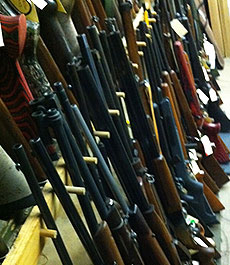
Field Dressing A Rabbit
When shooting rabbits, shot placement is very important. Head shots are preferred because they don’t damage any of the meat. Chest shots may be acceptable for a clean kill but result in meat destruction and waste. I wouldn't recommend eating any that have been gut shot. Apart from the mess cleaning them, intestine and stomach contents contaminate the meat.
Field dressing refers to the initial phase of carcass preparation and consists of removal of the skin, stomach and intestines with minimal meat exposure to anything that will contaminate it.
Field dressing should always be conducted off the ground to maintain good hygiene. Provisions should be made to allow the rabbit carcass to cool and prevent contamination with dust or flies. A good idea is to use a small game hook if hunting in a fixed position or even utilize a farm fence to hang meat and keep it off the ground.
- Start by making a small cut in the skin just down from the paw, this can be done with a small knife or a pinch with the fingers. On the other side leg make a similar cut in the same place. Run knife down the inside of each leg to join both cuts at the centre of the pelvis.
- Carefully pull the skin off of the rabbit in a downward motion with your hands and cut the base of the tail. Pull skin all the way down the body and over the head. At this stage head and front paws can be removed and discarded along with the skin.
- Gently cut around anus (bung) with knife, being careful not to pierce urine sack.
- On the under side of the rabbit make a small cut at the pelvis and gently cut down the stomach towards the front legs being careful not to cut stomach or gut. It is best to use a gut hook on a knife or the very tip of a small knife with fingers each side of the blade as not to contaminate the meat. Pull out stomach and unwanted organs including the bladder being careful not to spill or pierce the urine sack etc.
- Remove any unwanted organs including kidneys that have not come out with the stomach removal process. Do this with the fore finger and thumb or cut out with a small knife.
- Rinse any blood, hair or dirt from the carcass and place in a plastic bag or cover well to reduce contamination.
- Immediate cooking or freezing will turn any fresh meat into tough rubber - it causes irreversible shrinkage and toughening, thus ruining the eating quality. Once home store the carcass in the fridge for a few days allowing the muscle to tenderise.
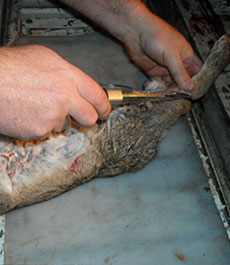
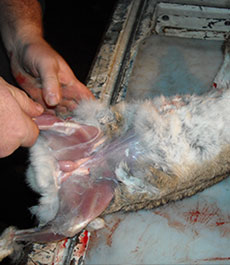
Field Dressing A Goat
Follow the general rules about field dressing (see above for rabbit) and watch the video below for further details.
Goat meat is much lower in saturated fat than lamb and is rich in protein and flavour. When cooking I treat it very much the same as lamb and even the cuts of meat are very similar.
Because of the low fat content this means it can easily dry out when cooking. Recipes such as curries, stews and even marinading the meat is recommended. If making burgers or sausages it is best to add fat to the recipe and a simple method is the introduction of bacon.
Goat meat teams well with thyme, olive oil, red wine, mint, garlic and rosemary. Cumin, chilli and curry are also other good additives.
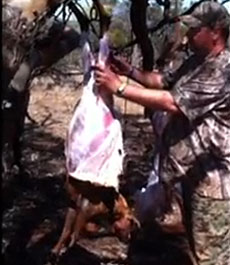
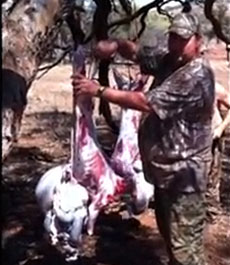
How do I know if a wild pig is ok to eat?
This is a question I get asked of me frequently. Once you have adopted a few simple animal husbandry techniques you will be well on the way to knowing.
I have harvested hundreds of wild pigs from the Australian farmlands and surrounding bush and consider it to be true free range pork. Below is a list of points I use pre and post harvest to determine the animal's health.
- Is the pig in general (good condition) for the time of year it is harvested? It will be in better condition in the cooler months than in the middle of summer (lots more food around and it wont have to walk to water).
- Is or does the pig move well? Runs off when chased, fights dogs, runs without a limp etc. If it is the last to run in a mob or it is weak it may be sick.
- Is there general sign the pig has been eating eg.: did you chase it off a crop?
- When shot or killed check for any external lumps, cuts, cysts etc and make sure the animal is in good condition - check the skin for lice and ticks.
- When field dressing, try not to cut the gut and check the liver for any abnormalities, including lumps, spots, cyst's etc. All organs are usually uniform in colour. Patches and white spots are signs of disease or parasites.
- All wild animals have lice, flea's, ticks etc. and by removing the skin you will remove them. You wont be scalding the pig unless you have trapped it live and had time to remove parasites from the skin.
- Worms only exist in offal, so if your dressing technique is good you will have no contamination. Always keep your equipment and knives clean. Keep the meat clean after field dressing.
- Boars over 30kg are really only good for sausages and cured meats. Like all animals, males produce testosterone and strong pheromones to mark there territory and attract females(this is why animals stink) Females are generally a lot cleaner.
- Smaller pigs are almost always better eating than older pigs - it's the same in every animal. Lamb compared to mutton, yearling beef compared to an old dairy cow. However older animals can still be utilised by simply changing the cooking method.
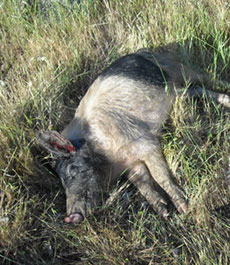

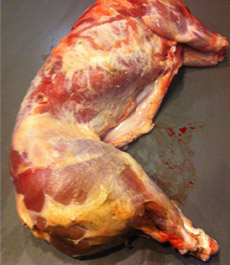
Gaining Access to Properties for Hunting
One of the biggest problems for novice hunters is gaining access on to properties to hunt. Even as a seasoned hunter with extensive knowledge of an area, gaining new properties can be somewhat difficult. If a previous hunter or poacher has done wrong by a farmer it will limit your chances dramatically.
One of the first encounters I had when seeking permission to hunt was a door slammed in my face after an abrupt NO.
The following hints on gaining access to new properties are a rough guide line to make access and permission easier.
- Networking - Talking to other like minded people or hunters is one of the better ways of gaining access to new areas. This comes in a couple of forms.
- Joining a hunting club and gaining new ground via the club as well as networking with in that club with members.
- Talking with friends, work colleagues or family members that may hunt and is happy for you to tag along with them.
- Word of mouth - One of the more common ways is word of mouth. Asking friends or relatives that may know someone to put in a good word for you or even asking for a contact name and number then ringing that farmer and mentioning you know that person. When hunting on existing properties I always go and ask the neighbouring properties and mention you hunt next door. This way has been very successful and I have managed to gain a lot more area with this method.
- Door Knocking - This is one of the most successful ways of gaining new properties. It shows the farmer that you are serious about hunting and meeting him first hand gives him a chance to ask any questions and see you are a genuine hunter that will make a effort to do the right thing. If you have made an effort to come all the way to his farm you will make an effort to do the right thing on his farm. As a farmer once said.... If you don't have the nerve to come and ask me for permission to hunt are you going to have the nerve to come and say, Hey look I am really sorry but I drove in to a fence last night or shot your water tank last night ect. Or are you just going to pack up and f.... off and post me a Christmas card next year.
When door knocking I found that leaving the farmer with some sort of contact information was a great benefit. I had business cards made that I would leave, however a printed flyer or pamphlet with what you are offering and the benefits it will bring the farmer would do the same thing. Some of the information should be:- The free service that you offer, such as feral pest control and management.
- The experience you have had eg.; the years you have been shooting, any clubs you may be a member of.
- Safe and fully insured with SSAA or a similar club or organisation.
- Contact name, home phone, mobile and e-mail address.
When approaching a farmer don't come with your hunting clothes on and gun's in the back as this can be viewed as over confident, rude or even over zealous. Dress neat and casual and appear to be well presented as this will give the property owner great first impressions.
I found talking to the farmer about a relevant subject and striking up a conversation such as the crop you noticed on the way in or weather can be most effective. Having a common subject when talking to people most always gets results. I have also found that taking the family or partner with you can be of great benefit as it shows you are a " normal person" and have things in common.
If permission is granted to the property ask for a map or even a quick tour when the farmer is not to busy so you can be as safe as possible while hunting. I have also found when hunting on more remote properties the offer to bring local paper, bread and fresh milk on the way makes a great impression with both the farmer and his wife. When on the property hunting, close all gates you find closed and leave with all rubbish. A quick phone call to say you are leaving and a thank you as well as reporting how many you have shot or any problems you see will be an invitation back and a good word to the neighbour.
If a farmer says no, accept the answer and thank him for his time. It may well be its just the wrong time to ask or maybe some one hunts there already. Be sure to come back in 6-12 months and ask again. The worst you can get is no again.
- Calling or E-mailing - finding phone numbers or e-mail addresses is some times effective however this I think this method is best used after a face to face meeting. Most farmers are out working most of the day and like myself the last thing you want to do is sit down and reply to an e-mail. However this method can be successful if worded correctly and can also canvas a lot of farms or properties with good results.
- Poster or Pamphlets - most farms don't have letter boxes and rely on a trip to town once a week for supplies. A sign or poster/pamphlet in the local general store or post office can be very effective. With tab tabs or cards on the bottom with numbers they can rip off or take home. This can jog peoples memories when looking or talking about a problem later on and the fact they took your information home with them will result in a call to you.
I hope this article helps and best of luck gaining access to new properties.

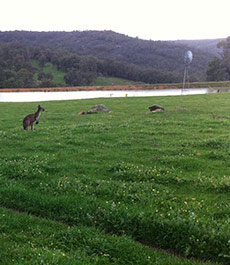

Firearm Cleaning and Care
Properly cleaning and regular inspection on your rifles will keep them functioning effectively and keep you safe. A gun should be cleaned after every time you go hunting or shooting and fire the gun and it is essential you clean it properly to avoid dangerous malfunctions.
Whether you purchase a cleaning kit pre assembled or make your own by purchasing items individually there are a few basic items you will require. These include:
- Cleaning solvent
- Lubricant or gun oil
- A bore brush (bronze bristle)
- A patch holder and patches
- Cleaning rod (same length as barrel)
- A nylon cleaning brush
- Cotton swabs
- Microfiber cloth for polishing
- Disassembly tool (screwdriver etc)
When you are cleaning your firearm you will also need a spacious place to work. You need enough room to fit the cleaning rod down the barrel. Remember most solvents and chemicals need to be in a well ventilated area. Cover your work area with old towels or news paper and ensure you have a solid surface where the firearm can not move. A gun vice or rest is perfect for this.
- Begin by removing (taking out) the bolt from the rifle. this ensures the gun is unloaded and makes it possible to push the cleaning rod from one end of the barrel to the other.
- Inspect and make sure (again) that the rifle is clear of rounds and there is nothing in the chamber. Spear a patch of the correct size on the bass jag and place a few drops of boar solvent on it. Pass the patch through the boar and out the muzzle. It will be stained with black residue and under no circumstances should be pulled back through the bore. Allow the patch to fall in to a container under the muzzle as you pull it back through the bore. Continue this step with bore solvent until patches come out clean.
- Take a bronze bristle brush of the correct diameter for the bore and pass it through the barrel from chamber end until it is fully exposed in front of the muzzle. Place about 10 drops of kerosene or non corrosive solvent on the brush and make about 10 passes through the bore. Note: (some people like to use cleaning solvent but as I have found this dramatically reduces the life of your cleaning brush as it is designed to dissolve copper.)
- Change end to cleaning jig again and run 2 more patches with a few drops of solvent on them through the bore again. This will clean off any fouling the brass brush has removed.
- Pass 2-5 clean patches through to remove any left over solvent.
- Pass 2 patches through the bore with good quality gut oil on them to prevent any corrosion before passing a clean patch through to remove any excess oil.
- With the bore now clean it is imperative you clean the rest of the rifle . If the firearm has become wet or in dirty condition you will need to remove the stock and ensure the barrelled action is cleaned thoroughly. Using a good quality spray oil and micro fibre cloth, give the trigger assembly and under side of the barrel a wipe before re fitting the stock. Ensure no excess oil is trapped in the stock as this can cause wooden stocks to swell and split.
- Using a moly-based grease dab a small amount on the sears of the bolt before giving it a wipe over with the oiled cloth and replace it in to the rifle.
- Using a small amount of spray oil on the micro fibre cloth (enough to prevent rust but not enough to collect dust). Rub the rest of the rifle including any areas you have been handling as well as the outside of the scope.
Store the firearm in a clean dry environment. With barrel resting against foam or carpet. This will help prevent scratches and spots as well as wear marks when moving the guns in and out of the cabinet.
